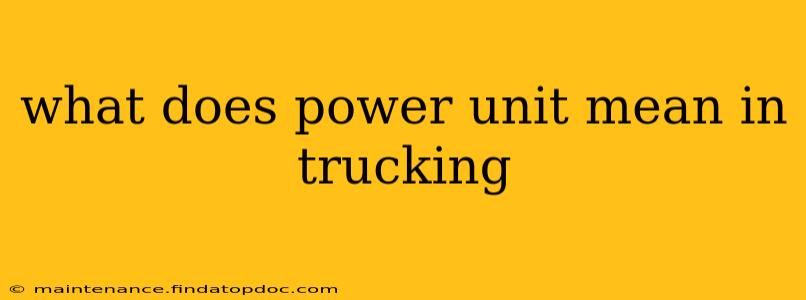In the trucking industry, the "power unit" refers to the tractor, or the truck itself, that provides the motive power to pull a trailer. It's the engine, transmission, cab, and chassis – everything that makes the truck move. Think of it as the "engine" of the entire trucking operation. It's distinct from the trailer, which carries the freight.
Understanding the term "power unit" is crucial for anyone involved in trucking, from drivers and dispatchers to fleet managers and logistics professionals. Let's delve deeper into what this term encompasses and address some common questions.
What is the difference between a power unit and a tractor?
The terms "power unit" and "tractor" are often used interchangeably in the trucking industry. While technically there's a slight nuance, in practical application, they mean the same thing: the vehicle that provides the power to move the load. The difference is mostly semantic; "power unit" is a more general term encompassing the entire self-propelled unit, whereas "tractor" specifically highlights its role in pulling trailers.
What are the components of a power unit?
A power unit consists of several key components working together:
- Engine: The heart of the power unit, responsible for generating the power to move the truck and its load. Diesel engines are the most common type in heavy-duty trucking.
- Transmission: Translates the engine's power into movement, allowing the driver to control speed and torque. Manual and automated manual transmissions are both used, with automated transmissions gaining popularity.
- Drivetrain: Includes the axles, differentials, and driveshafts, transferring power from the transmission to the wheels.
- Chassis: The truck's frame, supporting all other components.
- Cab: The driver's compartment, containing the controls and providing a workspace.
- Suspension: A system of springs and shocks that absorb road vibrations, improving driver comfort and vehicle stability.
- Brakes: Critical safety components, ensuring the power unit can stop safely and effectively.
What are some common types of power units?
The type of power unit used varies depending on the application:
- Class 8 Trucks: These are the heavy-duty trucks typically used for long-haul trucking and heavy loads.
- Medium-Duty Trucks: Used for shorter hauls and lighter loads.
- Day Cabs: Power units with smaller cabs, designed for shorter trips.
- Sleeper Cabs: Power units with larger cabs, including sleeping compartments for drivers on longer trips.
How is the power unit different from other parts of a trucking operation?
The power unit is the fundamental component that distinguishes a trucking operation from other forms of freight transportation. It's what allows for the flexibility and reach of over-the-road trucking. Without a properly functioning power unit, the entire transport operation is stalled. Other parts of the operation include:
- Trailers: The cargo-carrying portion of the transport.
- Drivers: Operate the power unit and are responsible for safe and efficient transportation.
- Dispatchers: Coordinate the movement of freight.
- Logistics Companies: Plan and manage the entire transportation process.
How much does a power unit cost?
The cost of a power unit can vary significantly based on factors like make, model, age, condition, and features. New Class 8 trucks can cost hundreds of thousands of dollars, while used power units range in price depending on their condition and mileage.
Understanding the term "power unit" is key to grasping the fundamentals of the trucking industry. It's the powerhouse behind the efficient movement of goods across the country and beyond.
